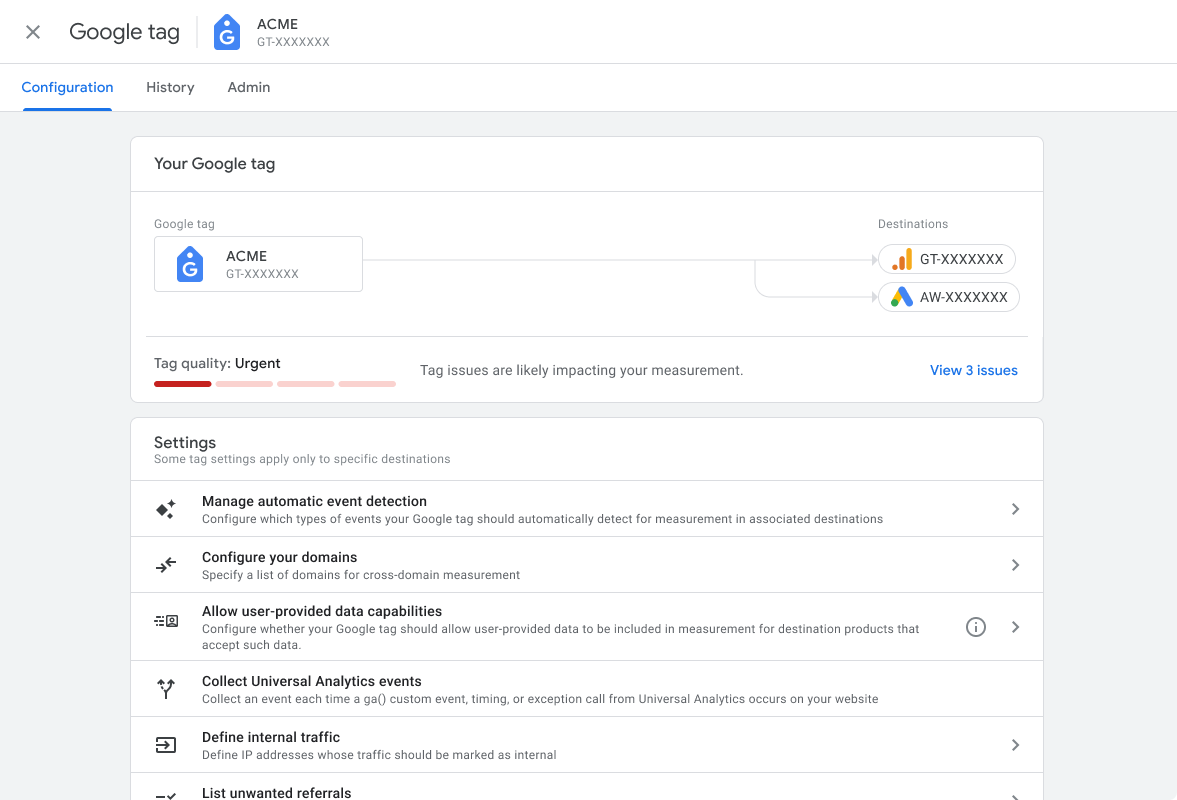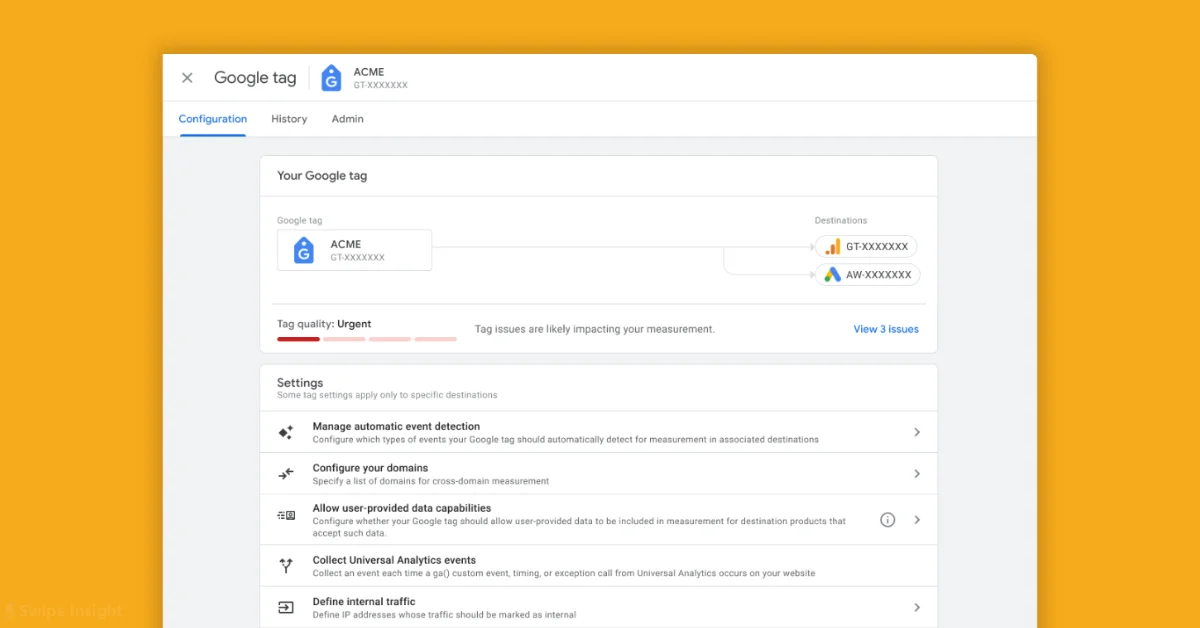Google has introduced a Tag Diagnostics Tool to enhance data quality. This tool helps users identify and fix tag issues efficiently.
Google’s new Tag Diagnostics Tool is a game-changer for digital marketers and web developers. It aims to enhance data accuracy by identifying and resolving tag-related issues quickly. Users can now diagnose problems with their tracking tags, ensuring data integrity across various platforms.
This tool simplifies the process of maintaining clean and reliable data, which is crucial for effective marketing strategies. By using this tool, businesses can improve their analytics, leading to better decision-making and optimized performance. The Tag Diagnostics Tool is an invaluable addition to Google’s suite of tools, making data management more straightforward and efficient.

Credit: www.searchenginejournal.com
Introduction To Tag Diagnostics
Google has introduced a new tool called Tag Diagnostics. This tool helps users improve the quality of their data. It is designed for better tracking and analytics. This makes it easier to fix issues with tags on websites.
Purpose Of The Tool
The purpose of the Tag Diagnostics tool is to find and fix tag issues. It checks if tags are working correctly on your website. This ensures you get accurate data. Accurate data helps in making informed decisions.
Importance Of Data Quality
Good data quality is crucial for any business. Poor data can lead to wrong conclusions. Correct data helps in better strategy planning. It also improves the performance of marketing campaigns. The Tag Diagnostics tool helps in maintaining this data quality.
| Benefit | Description |
|---|---|
| Accurate Tracking | Ensures all tags are working correctly. |
| Better Data | Improves the quality of collected data. |
| Informed Decisions | Helps in making better business decisions. |
- Checks for missing tags.
- Identifies broken tags.
- Helps in fixing tag issues.
Key Features
Google’s new Tag Diagnostics Tool aims to enhance your data quality. This tool offers several key features to improve your analytics and tracking. Let’s dive into these features to understand how they can benefit you.
Real-time Insights
The Tag Diagnostics Tool provides real-time insights into your tags. You can see immediate updates and changes. This helps you monitor the performance of your tags instantly.
Imagine knowing the status of your tags right away. This instant feedback helps you make quick decisions. You can track user interactions as they happen. This way, you ensure that your data collection is accurate and timely.
The tool also allows you to view real-time data in an organized manner. Below is a table showcasing the benefits of real-time insights:
| Benefit | Description |
|---|---|
| Immediate Updates | See changes as soon as they occur. |
| Quick Decisions | Make informed choices right away. |
| Accurate Tracking | Monitor user interactions in real-time. |
Error Detection
The tool excels at error detection. It identifies any issues with your tags immediately. This helps you fix problems before they impact your data.
You can find and resolve errors quickly. The tool provides detailed error reports. These reports guide you on how to correct each issue. This ensures your tags work perfectly.
Here are some key aspects of error detection:
- Instant Error Identification
- Detailed Error Reports
- Guided Troubleshooting
By catching errors early, you maintain high data quality. This feature saves you time and effort. It also ensures that your analytics are always reliable.
Setting Up The Tool
To make the most of Google’s new Tag Diagnostics Tool, you need to set it up correctly. This section will guide you through the initial configuration and integration steps to ensure your data quality is top-notch.
Initial Configuration
Start by accessing the Tag Diagnostics Tool from your Google Analytics account.
Follow these steps to configure it:
- Log in to your Google Analytics account.
- Navigate to the Admin panel.
- Select the property where you want to set up the tool.
- Click on Tracking Info and then Tag Diagnostics.
Ensure that you have the necessary permissions to make changes. You should have Edit access for the property.
Integration Steps
Integrating the Tag Diagnostics Tool involves a few key steps:
- Copy the provided tracking code snippet.
- Paste the code into the
section of your website. - Verify that the code is correctly implemented using the tool’s verification feature.
You can use the following code snippet as an example:
Once the code is in place, run a test to ensure data is being collected. This will help you identify any issues early on.
Using The Diagnostics Tool
Google has introduced the Tag Diagnostics Tool to help improve data quality. This tool helps users identify and fix issues with their tags. Understanding how to use this tool can enhance your data accuracy.
Navigating The Interface
The interface of the Tag Diagnostics Tool is user-friendly. The main dashboard displays an overview of all tags. It highlights issues that need attention.
Navigation is straightforward. The left sidebar contains key sections like Overview, Issues, and History. Use the top menu for settings and help options.
Clicking on each tag provides detailed information. This includes tag performance, errors, and recommendations.
Common Functions
Several key functions help users effectively manage their tags:
- Tag Overview: Shows a summary of all tags.
- Error Detection: Identifies issues in real-time.
- Recommendations: Offers solutions for detected errors.
- History Log: Keeps a record of all changes and updates.
Users can click on any issue to see detailed diagnostics. This includes error types, affected tags, and potential fixes.
Use the Export Report feature to download data. This helps in offline analysis and sharing with team members.
The Tag Diagnostics Tool is essential for maintaining data quality. It ensures that your tags are functioning as intended. This improves your website’s performance and user experience.
Benefits For Businesses
Google recently introduced the Tag Diagnostics Tool to enhance data quality for businesses. This tool offers various benefits that can significantly improve business operations.
Enhanced Data Accuracy
The Tag Diagnostics Tool ensures that data collected is accurate. Accurate data helps businesses make better decisions. The tool identifies and fixes errors in tags. This results in more reliable data.
Businesses can trust their data more. This leads to better analysis and strategy. Accurate data is key for successful marketing campaigns. It helps businesses understand their customers better.
Improved Decision Making
With accurate data, businesses can make better decisions. The Tag Diagnostics Tool provides insights that are more reliable. This helps in planning and executing strategies effectively.
Improved decision making can lead to higher profits. Businesses can allocate resources more efficiently. They can also identify trends and opportunities quicker. This gives them a competitive edge.
Table Of Benefits
| Benefit | Description |
|---|---|
| Data Accuracy | Ensures data collected is free from errors. |
| Decision Making | Allows for more informed and reliable decisions. |
| Resource Allocation | Helps in better distribution of resources. |
| Competitive Edge | Businesses can stay ahead of competitors. |
The Tag Diagnostics Tool is a valuable asset for businesses. It improves data accuracy and decision making. These benefits lead to better business outcomes.
Case Studies
Google’s new Tag Diagnostics Tool promises to improve data quality. Real-world examples prove its worth. Let’s explore some success stories and challenges overcome.
Success Stories
Many companies have seen significant benefits from the Tag Diagnostics Tool. Here are some examples:
| Company | Improvement |
|---|---|
| Tech Innovators | 25% better data accuracy |
| Retail Giants | 30% increase in customer insights |
Tech Innovators used the tool to fix tagging issues. They saw a 25% improvement in data accuracy. This helped them make smarter decisions.
Retail Giants used the tool for better customer data. This led to a 30% increase in valuable insights. Their marketing strategies improved greatly.
Challenges Overcome
Despite initial hurdles, many businesses overcame challenges with this tool. Here are some key challenges and solutions:
- Data Inconsistency: The tool helped identify and fix inconsistent tags.
- Implementation Issues: Step-by-step guides made the setup easier.
- Slow Data Processing: The tool optimized data flow, speeding up the process.
Tech Innovators faced data inconsistency. The tool identified mismatched tags quickly. This solved their issues fast.
Retail Giants struggled with implementation issues. The tool’s guides helped them set up smoothly. Now, they enjoy accurate data.
Both companies had slow data processing. The tool optimized their data flow. Now, their processes are faster.
Best Practices
Google’s new Tag Diagnostics Tool is here to help improve data quality. To get the most out of it, follow these best practices. They will ensure you capture accurate and useful data.
Regular Monitoring
Regular monitoring of your tags is crucial. It helps identify issues early and prevents data loss.
- Set up a schedule: Check your tags weekly or bi-weekly.
- Use alerts: Configure alerts for tag errors or data discrepancies.
- Review reports: Analyze the tool’s reports to spot trends and anomalies.
Addressing Common Issues
Addressing common issues can make your data more reliable. This includes fixing misfired tags and duplicate data.
| Issue | Solution |
|---|---|
| Misfired Tags | Ensure tags are placed correctly on all pages. |
| Duplicate Data | Check for duplicate tags and remove them. |
| Slow Load Times | Optimize tag loading to improve site speed. |
- Use tag managers: They simplify tag management and reduce errors.
- Test tags: Before going live, test tags in a staging environment.
- Document changes: Keep a log of all tag changes for easy troubleshooting.
Credit: support.google.com
Future Developments
The new Google Tag Diagnostics Tool is already helping many users. But what’s next? Let’s explore the future developments of this exciting tool.
Upcoming Features
Google plans to add more user-friendly features to the Tag Diagnostics Tool. These new features will make data tracking even easier.
- Real-time Alerts: Users will get instant notifications about tracking issues.
- Customizable Reports: Create reports tailored to your specific needs.
- Advanced Filtering: Filter data to see only what matters to you.
Long-term Vision
Google’s long-term vision for the Tag Diagnostics Tool is ambitious. They aim to make it an all-in-one solution for data tracking.
- Integration with other Google tools like Google Analytics.
- Enhanced machine learning capabilities for better data insights.
- Support for more third-party platforms.
These developments will help users get the most out of their data. Stay tuned for more updates!

Credit: web.swipeinsight.app
Frequently Asked Questions
What Is Google Tag Diagnostics Tool?
Google Tag Diagnostics Tool is a new feature to help improve data quality. It identifies issues with your tags and provides solutions.
How Does Tag Diagnostics Tool Work?
The tool scans your website for tag errors. It then reports these errors and offers actionable steps to fix them.
Why Is Data Quality Important?
High-quality data ensures accurate analytics and better decision-making. It helps in optimizing marketing efforts and improving user experience.
Can I Use The Tool For Free?
Yes, Google Tag Diagnostics Tool is free for all users. It’s integrated within Google Tag Manager.
Conclusion
The new Google Tag Diagnostics Tool enhances data quality for marketers. It simplifies troubleshooting and optimizes tag performance. By using this tool, businesses can ensure accurate data collection. This leads to better decision-making and improved marketing strategies. Embrace this innovation to stay ahead in the digital landscape.

